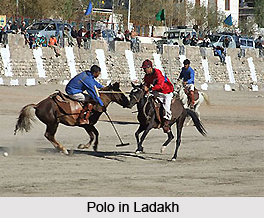 Polo in Ladakh, along with other games like trekking, mountaineering, white water rafting and camel safari, is one of the major games of Ladakh which has travelled a long way from Central Asia to the western and eastern parts of Northern India. Polo had been one of the most popular games of the great Karakoram Range which is popularly played in remote areas of Hunza, Nagar, Chitral, Gilgit and Balistan. As the traditional game of the land polo is usually played on every Tuesdays and Saturdays of Summer in the village polo ground though as an international game it takes place in the month of March 21st every year. It is usually played between two parties which include members from all the villages of Ladakh who together represent their region. As one of the most popular game of the region this game is accepted with lot of enthusiasm and people`s participation which brings colours of happiness in the region.
Polo in Ladakh, along with other games like trekking, mountaineering, white water rafting and camel safari, is one of the major games of Ladakh which has travelled a long way from Central Asia to the western and eastern parts of Northern India. Polo had been one of the most popular games of the great Karakoram Range which is popularly played in remote areas of Hunza, Nagar, Chitral, Gilgit and Balistan. As the traditional game of the land polo is usually played on every Tuesdays and Saturdays of Summer in the village polo ground though as an international game it takes place in the month of March 21st every year. It is usually played between two parties which include members from all the villages of Ladakh who together represent their region. As one of the most popular game of the region this game is accepted with lot of enthusiasm and people`s participation which brings colours of happiness in the region.
Origin of Polo in Ladakh
Polo in Ladakh is said to have travelled from far off regions of Central Asia where it has been claimed as the original game of the Iranians on one hand and the princes of Byzantine Empire on the other hand. The game which is very popular in the Nubra valley and the great Karakoram region was first introduced by the Muslim invaders who travelled from central Asia and ruled over the northern parts of India for more than 200 years.The game had been very popular in Akbar`s court which survived since then and flourished under the British rule who introduced it in Calcutta the then capital of India now Kolkata in 1860 which they discovered from Manipur. While it had been already discussed by the travellers who introduces the game as a major sports of the western Himalayan range, from there it travelled to regions of Punjab and parts of Himachal Pradesh. The British modified and improved the game and introduced their own rules, introduced the chukker system as a consideration towards the horses wgho were generally tied up and inthis process introduced the international game of Polo which was later on introduced as a major game in Indian Army.
Polo in Ladakh as mentioned earlier is played between two parties with each party consisting of six members who shall play to celebrate Nuroz, the Persian and Shia New Year. As per rules the players shall be permitted to throw the ball into the posts and a goal is awarded. The only cause for penalty shall be when one player shall try to cross over the other which is equally dangerous, otherwise there is no other rules accept the size of the ground the number of players who shall participate. The size of the field shall be determined by how big a patch of level ground can be spared from cultivation in this rugged terrain of steep mountains and narrow valleys. The goals are fixed at either ends of the streets and the players place themselves as the find convenient; and the strength of the team is determined by the number of good players present and playing while the minimum number is six for both the teams. It was in 1885 that Ladakh Chronicals laid down the lay-out of the polo ground in Leh. It is said that the game of Polo was brought to the land of Ladakh by Sengge Namgyal from Baltistan whose mother was a Balti princess; and who for the first time introduced the game as a royal game.
Polo as a State Game
Polo in Ladakh has been developed as a major part of Ladakh Tourism while a number of Associations like the Leh Polo Club and the Indian Polo Association have encouraged the growth of this game in the region which holds the pride and enthusiasm of the local ladakhi population. Since 1970s this game has received a lot of encouragement from the district administration as well. In the hilly regions of cold desert the game begins and ends with blowing of music and arrows which enchant the mountains of Karakoram Range.
Thus, Polo has been one of the most colourful and enthusiastic game of Ladakh which represents the traditions of the area and the popular participation of the people in the laps of Himalayas.



















